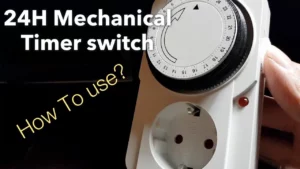Do you want to connect a portable generator to the home as a backup power source? In this case, it is necessary to install a transfer switch. When installing the transfer switch, not only must safety measures be taken, but also relevant house laws and regulations must be observed.
This article will explain what a transfer switch is, the different types of transfer switches, and how to choose the correct transfer switch for your building.
1. What is a transfer switch?
Basically, a transfer switch transfers power between two electrical sources. Under normal conditions, the transfer switch is installed near the electrical panel, between your house and the generator. In case of a power outage, you can use the transfer switch to provide power to the circuit of your choice.
After installing a safe and compliant transfer switch, you will not need to install an extension cord for each unit. The extension cord shuttles between the pedestrian area, doors and windows, and various electrical appliances. Fire threats include pinching wires and stepping on wires. Even if it’s just a crack, passing an extension cord through an open window can cause carbon monoxide to reach the building.
In addition to eliminating inconvenient electrical cords, the transfer switch maintains the stability of a household’s power supply. After installing the transfer switch for the portable generator, you can run hard-wired equipment on the electrical panel, such as heaters, well pumps, or water heaters.
2. Why is it a smart idea to use a transfer switch to connect a portable generator to home appliances?
(1) This is a summary of national electrical regulations.
The National Electrical Code (NEC 700.5 and 701.5) stipulates that a transfer switch should be installed in houses with generators. When using a portable generator to power home appliances, the correct transfer switch is installed. This is especially important if you plan to sell your house in the future, as improper installation may result in violation of regulations.
(2) This is the easiest way to supply power during a power outage.
Most important electrical appliances, such as air conditioners, stoves, and water heaters, are hard-wired and cannot be connected to generators. In addition, during a power outage, it will be extremely difficult to find, untie, and operate an extension cord. When the power fails, the transfer switch automatically switches the power source to the portable generator, providing a fast, convenient and reliable alternative power source. (3) Connecting the portable generator to the home in this way is the safest choice. An extended extension cord can cause power to be fed back to the utility line. This increases the risk of fire or electric shock, both of which can cause serious injury or death.
3. Things to note when buying a transfer switch
(1) Rated current, rated voltage
One of the most important characteristics of a transfer switch is the rated current and rated voltage it can handle.
This is crucial: you must decide which circuits you want to power through the switch and measure the power required to run these circuits.
(2) Related certification
Most branded products are eligible for certification, but this is a good idea and requires repeated checks to ensure that they meet the requirements.
(3) Warranty period
As with every purchase, you may want to reconfirm the warranty period provided by the company.
4. Transfer switch type
There are two main types of transfer switches: manual transfer switches and automatic transfer switches.
The manual transfer switch allows you to manually switch power from the grid to the generator by tapping the switch. However, they cannot automatically handle generators or high-voltage loads. These switches are cheaper than ATS (Automatic Transfer Switches), but they must be turned manually in the event of a power failure.
ATS (Automatic Transfer Switch) can automatically sense power-off. As soon as the generator starts, the ATS switches the power supply from the grid to the generator and sends a signal to the ATS to make the primary circuits such as water pumps, refrigerators, freezers, heating and air-conditioning operate normally. In addition, the ATS can be configured to automatically control the circuit with the highest priority in the event of a power failure. The price of ATS is usually higher than manual transfer switch because it has more functions and higher maximum power rating.









